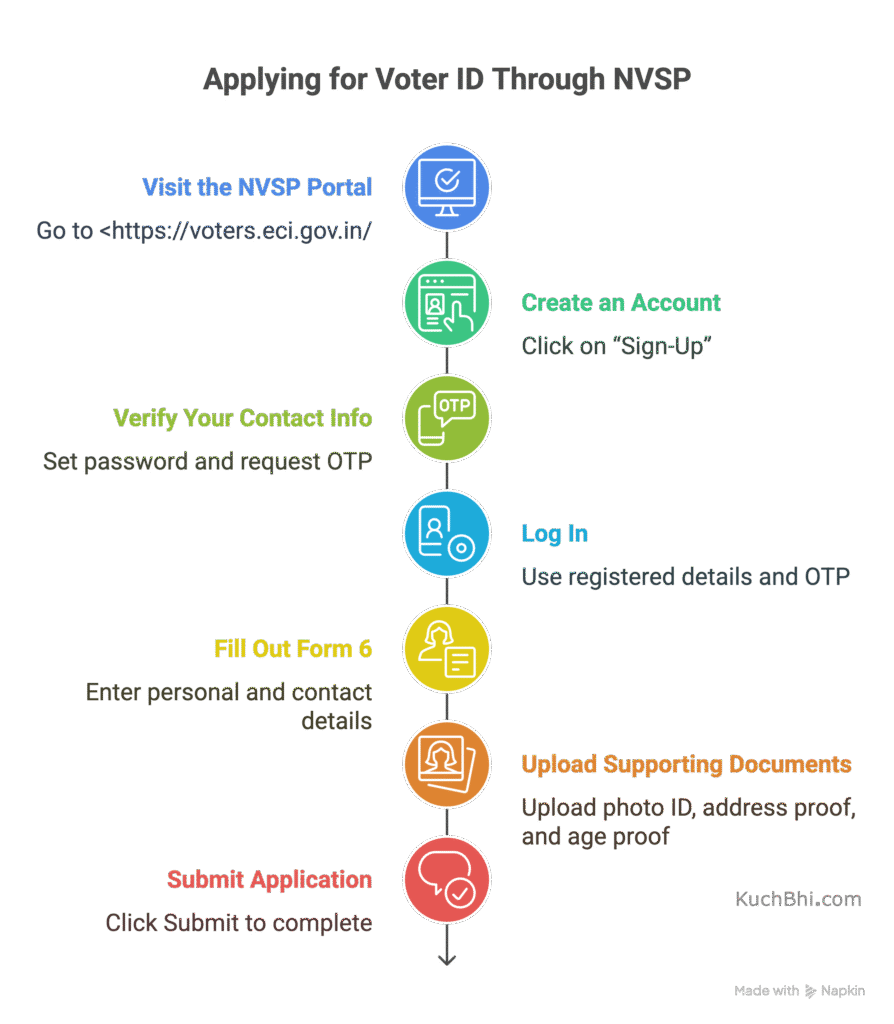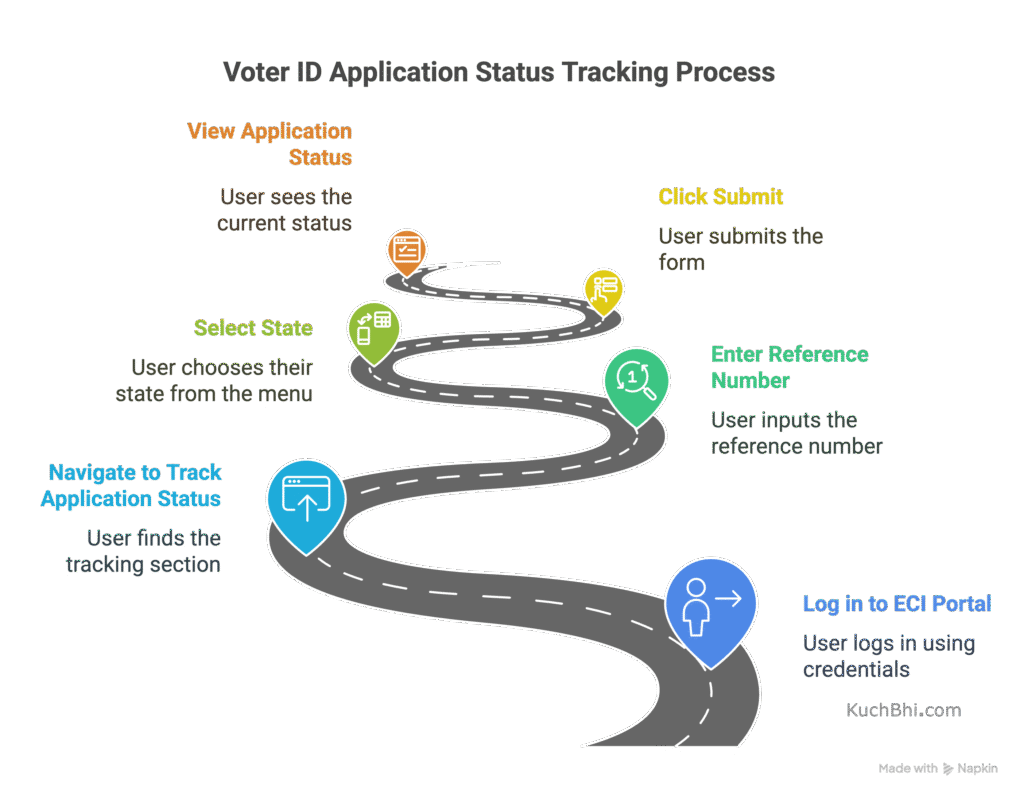Voter ID: In a welcome move to improve efficiency and transparency, the Election Commission of India (ECI) has announced that Electors’ Photo Identity Cards (EPICs) will now be delivered within 15 days of updating the electoral rolls. This is a significant improvement over the current system, where it typically takes over a month for voters to receive their Voter ID cards.
In today’s fast-paced world, ensuring you have your voter ID ready in time for the elections has never been more crucial. Whether you’re a first-time voter or a seasoned pro, navigating the application process can be daunting. But fear not! Our comprehensive step-by-step guide will illuminate the path to obtaining your voter ID in just 15 days.
We’ll break down each stage of the application process, providing you with helpful tips to streamline your experience. Plus, you’ll learn how to track your application online, ensuring you’re always in the loop. With the right information at your fingertips, you can focus on what truly matters—making your voice heard at the polls. Get ready to embark on this essential journey and secure your voter ID with confidence!
Understanding the Importance of a Voter ID
In the democratic fabric of India, the Voter ID card holds a place of paramount importance. It is not merely a document; it is a symbol of your right to participate in the electoral process. This card serves as proof of identity and address, enabling eligible citizens to cast their votes during elections. Without it, exercising your franchise becomes significantly more challenging, as the card is required at polling booths to validate your identity.
Having a Voter ID card is not just about fulfilling your civic duty; it’s about empowering yourself to be part of the decision-making process that shapes the future of your country. It ensures that your voice is heard and contributes to the democratic governance of the nation. Moreover, the Voter ID card also helps in maintaining the integrity of elections by preventing fraud and duplication, ensuring that each vote cast is legitimate.
In addition to its primary function in elections, the Voter ID card also serves a secondary purpose as a valid identification document. It can be used for various administrative tasks, such as opening bank accounts, applying for government schemes, and more. Thus, possessing a Voter ID card is essential not only for voting but also for broader identification needs, making it a crucial document for every eligible citizen.
Eligibility Criteria for Voter ID Application
Before you embark on the journey to obtain your Voter ID, it’s important to understand the eligibility criteria set forth by the Election Commission of India (ECI). Firstly, you must be an Indian citizen. Citizenship is a fundamental requirement, as the Voter ID card grants you the right to vote in Indian elections and participate in the democratic process.
Secondly, you must be at least 18 years old on the qualifying date, which is typically January 1st of the year in which the electoral roll is revised. This age requirement ensures that voters are mature enough to make informed decisions during elections. If you are turning 18 before the next election, you can apply for your Voter ID in anticipation of your birthday.
Additionally, you must reside in the constituency where you are applying for the Voter ID. Residency is verified through various documents, which we will discuss in the next section. Ensuring that you meet all these criteria is crucial, as any discrepancies can lead to delays or rejection of your application. Understanding these eligibility requirements will help you prepare the necessary documents and streamline your application process.
Required Documents for Voter ID Application
To apply for a Voter ID card, you need to furnish certain documents that establish your identity, age, and residence. The first document you will need is proof of identity, which can be any government-issued photo ID. Commonly accepted documents include your Aadhar card, passport, driving license, or PAN card. These documents help verify that you are who you claim to be.
Next, you’ll need proof of age. This can be provided through your birth certificate, school leaving certificate, or any other official document that mentions your date of birth. Ensuring you have the correct document is crucial for meeting the age eligibility criteria. Without valid proof of age, your application might face unnecessary delays.
Finally, proof of residence is required to confirm that you live in the constituency where you are applying for the Voter ID. This can be a utility bill (electricity, water, gas), rental agreement, or bank statement that mentions your address. Remember, the address on your proof of residence must match the address you provide in your application. Gathering these documents beforehand will make the application process smoother and faster.
Step-by-Step Guide to Applying for Your Voter ID Online
Applying for your Voter ID online is a straightforward process, thanks to the user-friendly portal provided by the Election Commission of India. The first step is to visit the National Voter’s Service Portal (NVSP) website. Once there, you need to register yourself by providing basic details such as your name, email address, and mobile number. This registration will give you access to the application form.

Upon submission, you will receive an acknowledgment receipt with a unique application ID. This ID will be crucial for tracking the status of your application.
Tracking Your Voter ID Application Status
Once your application is submitted, the next step is to track its status to ensure everything is moving smoothly. The Election Commission of India provides an online tracking system that allows applicants to monitor the progress of their Voter ID application. To track your application, visit the Voter Service Portal website and log in using your credentials.

Tracking your application regularly helps you stay informed about any potential issues or delays. If your application is taking longer than expected, you can contact the ECI helpline or visit your local electoral office for assistance. Keeping a close eye on the status ensures that you receive your Voter ID card within the promised 15-day timeframe, allowing you to be prepared well in advance of any upcoming elections.
Common Issues and Troubleshooting Tips
Despite the streamlined process, applicants may sometimes face common issues that can hinder the progress of their Voter ID application. One frequent problem is the rejection of documents due to poor quality or incorrect information. To avoid this, ensure that all uploaded documents are clear, legible, and match the details provided in the application form.
Another issue could be incorrect or incomplete information in the application form itself. Double-check all details before submitting the form, especially your name, date of birth, and address. Any discrepancies can lead to delays or rejection. If you realize you’ve made a mistake after submission, contact the ECI helpline immediately to rectify it.
Sometimes, applicants might face technical glitches on the NVSP website, such as slow loading times or errors during form submission. In such cases, clear your browser cache, try using a different browser, or attempt the process at a different time when the website traffic is lower. If technical issues persist, reach out to the NVSP support team for assistance. Being proactive in troubleshooting can help you avoid unnecessary delays.
How to Update or Correct Your Voter ID Information
If you find that your Voter ID card contains incorrect information or if you need to update certain details, the ECI provides a straightforward process for corrections. To initiate an update or correction, visit the NVSP website and log in to your account. Look for Form 8, which is specifically designed for making corrections to the electoral roll.
Fill out Form 8 with the correct information and specify the changes you wish to make. For example, if your name is misspelled or your date of birth is incorrect, provide the correct details in the form. Additionally, you will need to upload supporting documents that verify the corrected information, such as a birth certificate, passport, or Aadhar card.
Once the form is filled and the documents are uploaded, submit the application for review. The ECI will process your request, and you can track the status using your application ID. Corrections typically take a few weeks to be reflected in the electoral roll, so it’s advisable to check the updated status regularly. Ensuring your Voter ID card has accurate information is vital for smooth voting experiences.
Voter ID Application Fees and Payment Methods
One of the most attractive aspects of the Voter ID application process is that it is completely free of charge. The Election Commission of India does not levy any fees for applying for a new Voter ID card, making it accessible to all eligible citizens irrespective of their financial status. This free service underscores the importance of democratic participation and ensures that no one is excluded due to economic barriers.
However, if you need to make corrections or updates to your existing Voter ID card, there might be a nominal fee involved. This fee is generally minimal and is used to cover administrative costs. The exact amount and payment methods can be checked on the NVSP website or by contacting your local electoral office. Typically, payments can be made online through secure gateways, ensuring convenience.
For those who prefer offline methods, payments can also be made at designated electoral offices. It’s advisable to keep the payment receipt safe, as it might be required for tracking your application or for future reference. Understanding the fee structure and available payment methods can help you navigate the process smoothly and avoid any surprises.
Frequently Asked Questions About Voter ID
As with any official process, there are often numerous questions that arise when applying for a Voter ID card. One common query is about the eligibility criteria for first-time voters. As mentioned earlier, you must be an Indian citizen and at least 18 years old to apply. If you meet these criteria, you are eligible to submit your application.
Another frequent question is about the time frame for receiving the Voter ID card. With the new system in place, the ECI aims to deliver Voter ID cards within 15 days of updating the electoral rolls. However, tracking your application status regularly can help ensure there are no delays. If you face any issues, contacting the ECI helpline can provide guidance.
Applicants often wonder about the necessity of submitting multiple documents. While it may seem cumbersome, providing proof of identity, age, and residence ensures the integrity of the electoral process. These documents help verify your eligibility and prevent fraudulent applications. Understanding the rationale behind these requirements can make the process more comprehensible.
Conclusion and Final Tips for a Smooth Application Process
Applying for a Voter ID card is a crucial step in fulfilling your civic duty and participating in the democratic process. With the ECI’s improved system, obtaining your Voter ID within 15 days has become significantly more efficient. By following the step-by-step guide provided, you can navigate the application process with ease and confidence.
Remember to gather all required documents beforehand and double-check the information you provide in the application form. Regularly tracking your application status will keep you informed of any potential issues, allowing you to address them promptly. If you encounter any challenges, the ECI helpline and support team are there to assist you.
Ensuring you have your Voter ID ready in time for the elections empowers you to make your voice heard and contribute to the governance of your country. With the right information and a proactive approach, you can secure your Voter ID seamlessly and focus on what truly matters—participating in the democratic process and shaping the future of India.


1 comment
This is very much helpful. Thx for sharing quicker process.